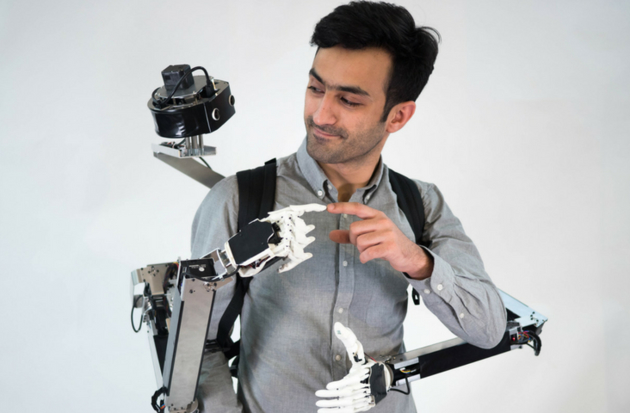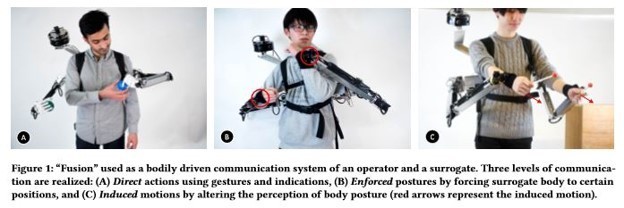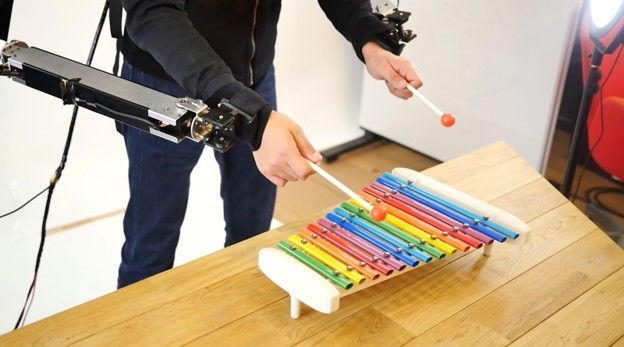Robotic Arms 'Fusion'
Two Arms Good, Four Arms Better?

Source:Keio University Graduate School of Media Design
Fusion, a research project led by Yamen Saraiji from the Keio University Graduate School of Media Design, aims to utilize robotic arms for human enhancement. However, this classic idea of robotic arms has an odd twist: The two extra arms are controlled by someone other than the user.
Views
Two Arms Good, Four Arms Better?
By Alex Grayweb only
Researchers in Tokyo have been working on a set of robotic arms that they say could help us communicate better.
Unlike other robotic arms, these ones don’t replace any missing limbs. Rather, they enhance what we can already do.
Although it’s still only a prototype, its makers say their invention could have many applications, and hope to be able to scale it up into something commercially useful.

Image: Keio University Graduate School of Media Design, The University of Tokyo
How Does It Work?
The idea behind Fusion, a research project led by Yamen Saraiji from the Keio University Graduate School of Media Design, is that two people can effectively share the same body.
One person - the controller - wears a virtual reality headset and uses handheld controllers to control the robotic arms.
The other person wears a backpack that contains the two robotic arms, a camera, and a battery pack. The camera feeds visual images to the virtual reality device.
The controller can move the robotic arms to help the wearer to complete certain tasks, such as fitting pieces of an electronic circuit together, as shown in this video.
In addition, the robotic arms can be strapped to the wrists of the wearer, to move their own arms in the right direction. This is useful for teaching them how to do something, such as how to play a xylophone.
Although the backpack weighs 21 pounds, it’s still light enough to move around - and can be used outdoors. The battery pack lasts about an hour and a half.
 Robotic arms help this person learn how to play the xylophone (Image: Keio University Graduate School of Media Design, The University of Tokyo)
Robotic arms help this person learn how to play the xylophone (Image: Keio University Graduate School of Media Design, The University of Tokyo)
The researchers say that they are trying to improve situations where we have to share skills and actions with each other, either in social or professional settings.
The idea behind the invention is to enable two people to work together even when they are far apart in actual location.
The researchers suggest their invention could also be used in physical therapy.
A System Upgrade
Fusion is an upgrade from Saraiji and his team’s previous invention, MetaLimbs, whereby a person could wear a pair of robotic arms controlled by moving their feet, but this invention proved to be a little unwieldy.
The researchers said that, while other studies have tried to do the same thing using camera and voice technology, theirs is the first to actually be able to force bodily movements.
Other research has looked at Electro Muscle Stimulation (EMS) but they say this lacks the ability to produce continual motion trajectory, and soon causes muscle fatigue.
The researchers are now hoping to get the funding to explore their invention further.
Edited by Shawn Chou
Additional Reading
♦ Huang Yi: My Dance Partner Is Not A Human
♦ The Promise and Peril of Immersive Technologies
♦ Hiroshi Ishiguro: Social Robots to be the Next Smartphones
Original content can be found at the website of World Economic Forum.
♦ This man has four arms - two of which are controlled by someone else
This article is reproduced under the permission of World Economic Forum (WEF) and terms of Creative Commons Attribution-NonCommercial-NoDerivs 4.0 Unported License (“CCPL”). It presents the opinion or perspective of the original author / organization, which does not represent the standpoint of CommonWealth magazine.







